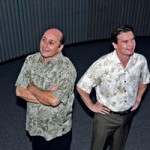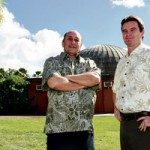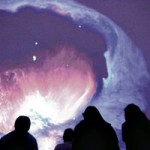When You Wish Upon A Star
Photo by Nathalie Walker
After two decades of wishing, Bishop Museum is finally celebrating the opening of an all-new, world-class planetarium. Leading the cheers – and offering a special tour for MidWeek readers – are planetarium director Mike Shanahan and museum president/CEO Blair Collis
Can Bishop Museum find relevance in the stars? If its newly renovated planetarium opening next week is any indication, the answer is yes. Just as stars guided ancient Polynesians navigators, Hawaii’s revered depository of history and natural science hopes to find its way to a destination.
We’re all invited on Bishop Museum’s journey of enlightenment. Best of all, this flight into the future requires only your sense of curiosity and love of the Islands. No space suits or rockets required.
Although if you visit the amazing, amped-up planetarium, you’ll see how you can virtually engage in space travel and never leave Kalihi. The only boarding pass you need is an admission ticket to Bishop Museum.
This holiday period is a good time to experience the new planetarium and discover the museum’s many other offerings. General admission, $8.95-$10.95 for kamaaina, gives you entry to all the facilities and programs at this cultural gathering place. Take the family – or a date – to the hottest ticket in town.
To celebrate the reopening of the Jhamandas Watumull Planetarium, an expanded schedule of programs is offered Dec. 15 through Jan. 2. It includes a 20-minute “New Planetarium Extravanganza” showing off its full-dome program; the popular “Sky Tonight” live tour of Hawaii’s night sky enhanced by a new digital projection; “Awesome Light,” an exploration of the Mauna Kea observatory and its cutting-edge astronomy; and “Explorers of Polynesia” that tracks canoe Hokulea on its Hawaii to Tahiti voyage.
Presentations are every 30 minutes with repeat performances.
Even if you’ve seen these shows before, you should return to experience it with the digital razzle dazzle and electronic wizardry that’s been added. You will be starstruck as never before.
After a three-month renovation, the 70-seat planetarium reopens Saturday, Dec. 15, with a new seamless interior dome, debut of the Chronos II star machine that provides the most realistic replica of the night sky, and the latest Digistar 5 full-dome video system.
Be amazed as a hybrid control system synchronizes perfectly the star projector and video system. For example, an image of the planet Jupiter from the Digistar video can be superimposed on the panoramic Chronos sky. The planet image also can be enlarged so it covers the entire dome. Very sexy stuff.
The spruced-up planetarium has new chairs, lights, carpet and sound system. Chairs are set at an angle for comfortable dome viewing. No neck craning.
Coming into the digital age means retiring the planetarium’s slide projector system that told the story of Hawaii’s skies for many years. You remember slide projectors, don’t you?
“Kodak doesn’t even make ’em anymore,” laughs Mike Shanahan, Bishop Museum’s director of education, exhibits and planetarium. “I don’t have to come in at midnight to replace burnt-out photo slides.
“Technology is a marvelous teaching tool,” he boasts, “but we will never lose the human touch to interacting with our guests.”
The veteran museum staffer should know. He has organized Honolulu’s most memorable astronomy events for the past 13 years. Shanahan is an impresario of the skies.
“Bishop Museum has discussed the renovation of our planetarium for more than 20 years,” he says. “Thanks to the ($1.5 million) support of the state of Hawaii, this dream of a state-of-the-art planetarium has finally come true. Now we can fully immerse the audience in outer space in a way we could never do before. We can fly through the rings of Saturn, go forward a million years in time and show how the stars change. Flexibility is off the hook.”
See what happens when you wish upon a star?
Aspirations, whether it be reaching for the stars metaphorically or developing a strategic plan, are not lost on museum president-CEO Blair D. Collis. Reinventing Bishop Museum for the 21st century is all about seeking relevance, he claims.
Collis, 40, has been in the top post since June 2011. The Australia native ascended the ladder of leadership as director of Bishop Museum Press, director of sales and marketing, vice president of public operations, and senior vice president and chief operating officer.
Under Collis’ leadership, Bishop Museum restored Hawaiian Hall in 2009, completed its award-winning Native Hawaiian Garden in 2010, and is in the process of restoring Polynesian Hall.
“A museum, in the best-case scenario, is a forum for education,” Collis says. “It’s not just a collection of static displays. It must be an interactive, informative, vibrant place for people to experience things.
“We’re a gathering place,” he adds. “We are a forum for conversation in the community and a model of lifelong learning.
“(Bishop Museum) is a long-lived institution. It’s easy to become entrenched,” he admits. “We are in the process of reinventing the leading Hawaiian cultural museum in the world to reveal the depth of this institution. The state-of-the-art Planetarium is an embodiment of that.”
Partnerships have allowed exciting programming. A grant from the Castle Foundation allowed the museum to create new planetarium programming for young children, which will debut this month. A new program on Polynesian navigation also is in the works. The program is being created as part of a U.S. Department of Education-funded partnership with Polynesian Voyaging Society led by Hawaiian navigator Nainoa Thompson and University of Hawaii’s College of Education.
A grant from the National Aeronautics and Space Administration (NASA) will fund a portable digital planetarium, allowing educational outreach to the Neighbor Islands. Curricula development, programming and a new exhibit on NASA earth sciences are part of the project.
“This is the most important year for our planetarium in a very long time,” says Shanahan.
Originally called the Kilohani Planetarium, the Watumull Planetarium – named for local retail store pioneer Jhamandas Watumull – has served more than 6 million visitors and students since it opened in 1961.
Honolulu’s planetarium is one of more than 3,000 worldwide but one of only six in the nation with the digital hybrid system. Its sophisticated Digistar system and software contains the most comprehensive set of astronomical data ever assembled, including proprietary input from the American Museum of Natural History and NASA.
With growing interest in extraterrestrial phenomena, including space travel and moon explorations, Hawaii and Bishop Museum are well-positioned to play key roles. Who would have guessed when the ancient Polynesians followed the stars to discover these islands that their venture-some spirit would manifest itself in progressive opportunities centuries later?
It’s poetic that Bishop Museum’s “new” planetarium is being unveiled in mid-December, the start of the traditional makahiki season. Ancients celebrated this time to harvest and renew the gifts of the earth, as well as rededicate themselves spiritually to peace and harmony.
Astronomical highlights for 2013, according to Shanahan, include a partial eclipse of the sun May 9 when one-third of the sun will be covered by the moon. The annual Perseid meteor shower peaks Aug. 11-12, when viewing will be good for meteor hunting from midnight till dawn.
Shanahan says next summer will be an excellent time for viewing Saturn and its rings. The planet will be tipped nicely for Earthlings to view the sixth planet from the sun.
But if you miss all of those events, you can simulate the experience by sitting in a comfortable seat in the Bishop Museum planetarium and watch the night sky on its 30-foot dome theatre.
Now that’s the kind of dancing with the stars we can all champion.
Bishop Museum, 1525 Bernice St., is open 9 a.m. to 5 p.m. daily except Tuesdays and Dec. 25. Phone 847-3511. website: bishopmuseum.org.
- Mike Shanahan, Bishop Museum Director of Education, Exhibits & Planetarium (Right) Blair Collis, President and CEO of Bishop Museum
- GOTO Chronos II Star Machine
- Shanahan and Collis outside the planetarium
- Students from Kamehameha Schools







